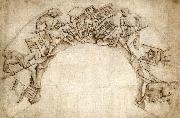
|
WEYDEN, Rogier van der
|
|||
|
|
|||
| Netherlandish Northern Renaissance Painter, ca.1400-1464 major early Flemish master, known also as Roger de la Pasture. He is believed to have studied with Robert Campin. His early works also show the influence of Jan van Eyck. Van Eyck, however, had been a master at objective rendering of detail, whereas Roger in his work portrayed emotions with an assurance that has not been surpassed. His ability to depict piety is reflected in the early masterpiece Descent from the Cross (c.1435; Prado); he depicted with significant restraint the profound grief of the mourners grouped around the tragic figure of Jesus. His composition strongly affected later representations of the theme. Roger became City Painter in Brussels in 1436. He then produced a series of undated altarpieces including the Last Judgment (hospital, Beaune), the Braque Triptych (Louvre), Crucifixion with Donors (Vienna), and Adoration of the Magi (Berlin), which vary in execution from a stress on sumptuous details to a more sculptural rendering of the figures. Roger is believed to have made a pilgrimage to Italy in the holy year 1450. Whether this supposed excursion had any effect on his style is much debated. It has been shown that his Entombment (Uffizi) bears an affinity to the Tuscan treatment of the subject, particularly by Fra Angelico, and that Roger's Virgin and Child with Saints (Frankfurt) has a strong resemblance to the Italian religious art of the day. His style is, however, highly individual. His religious paintings and his portraits are characterized by a straightforward monumentality. The portraits, such as that of a young lady (National Gall. of Art, Washington, D.C.) and of Francesco d'Este (Metropolitan Mus.) exhibit a simple clarity of contour and psychological penetration. Other notable works are his St. Luke Painting the Virgin, of which a version or replica is in the Museum of Fine Arts, Boston, the Crucifixion | |||
|
|
|||
|
Scupstoel new21/WEYDEN, Rogier van der-947927.jpg Painting ID:: 63875 |
1447-50 Pen over chalk tracing on paper, 298 x 425 mm Metropolitan Museum of Art, New York The curious drawing of the Scupstoel is connected not with a painting but with a sculpture, more precisely the relief ornamentation of a capital. This capital belonged the pillars on the lower floor of the west wing of the Brussels town hall, built from around 1447 to 1450, and although severely damaged it is still extant. Exactly reflecting the motif of the drawing, a carving of men shoveling chairs (a literal translation of the word "Scupstoel" = shovel chair) runs in high relief around the entire capital. The drawing represents a development of the curved surface of the conical architectural member. It cannot have been actually copied from the relief, for a draftsman wishing to record the different aspects of the capital would have either drawn the figures individually or shown the whole scene as a flat strip. The drawing must thus have been connected with the design of the capital, with its special manner of surface projection corresponding to the requirements of the sculptors carving the relief. However, the drawing, which is relatively well preserved in spite of its large dimensions, cannot have been the actual model, which would have been worn out with intensive use. It seems very likely that the Brussels city council turned to their painter Rogier with a commission to design the capital. He must have prepared the basic design of the scene, and both the model followed by the sculptors and the extant drawing were presumably then copied from that design. Their author would have been an assistant in Rogier's workshop, perhaps one of the painters who participated in work on the panels of scenes from the life of St. Hubert (National Gallery, London), in which the faces of certain figures in the background are strongly reminiscent of the heads of the shoveling men. Perhaps Rogier himself merely sketched out the design and then directed his assistants to prepare a more detailed drawing as a model for the city council who had commissioned it. Or perhaps his design passed into the hands of the council, and he had a copy made by his assistants for the workshop stocks.Artist:WEYDEN, Rogier van der Title: Scupstoel Painted in 1401-1450 , Flemish - - graphics : other | ||
|
|
|||
|
Also Buy::. For Following Paintings / Artists / Products, Please Use Our Search Online: |








